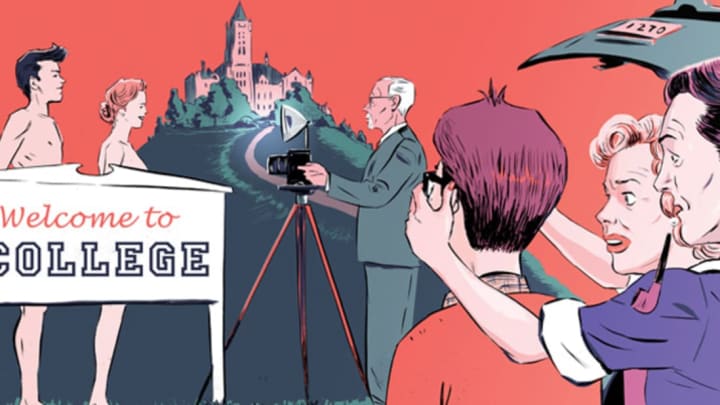Freshman orientation is easily the most awkward part of college. But if you were a student at one of America’s elite universities during the middle of the 20th century, it was really awkward: From the 1940s to the 1960s, incoming students at schools like Yale, Vassar, Harvard, Syracuse, Purdue, and Wellesley were required to pose for a series of nude portraits.
One by one, freshmen were led into a room full of men decked in white and instructed to undress. There were no forms or waivers to sign, no choice to opt out. Once the student disrobed, the men taped metal pins to his or her spine. Then the student posed for pictures from three angles—front, side, and back. The official story was that it was to help identify posture problems. But this wasn’t entirely true.
The “posture picture project” was led by William Herbert Sheldon, a psychologist who was, incidentally, the world’s leading authority on American pennies. Sheldon used thousands of nude photos to build a taxonomy of body shapes called somatotypes. He classified people into one of three groups: ectomorphs (tall and skinny), endomorphs (round but solid), or mesomorphs (compact and muscular). His ideas were wildly popular at the time. In 1951, LIFE magazine dedicated a cover story to Sheldon’s work, and the tobacco industry used his Ivy League nudes to study the relationship between smoking and masculinity.
But Sheldon was doing more than classifying people’s looks. He believed your physique correlated with your intelligence, social standing, behavior, morals, and future success. “The inspiration came from the founder of social Darwinism, Francis Galton, who proposed such a photo archive for the British population,” George Hersey, an art history professor at Yale, told Ron Rosenbaum of The New York Times Magazine in 1995. Sheldon, it appeared, still had faith in one of the century’s most regrettable trends: eugenics.
Sheldon took thousands of pictures, including those of later power players like George Bush and Diane Sawyer. His book Atlas of Men, published in 1954, contained hundreds of Harvard nudes. But when Sheldon began Atlas of Women, he hit a snag. A student at the University of Washington complained, and lawyers stormed his lab to burn his photos. As the 1960s progressed, and as more people doubted his theories, colleges nixed the program. “[What] masqueraded as science ... now looked like a kind of kinky voodoo ritual,” writes Rosenbaum. Today, Sheldon’s ideas about physiology and social status have been relegated to a place among some of history’s worst, and most of the nude photos have been incinerated. Now, thankfully, the only thing to dread about freshman orientation is that icebreaker where you have to come up with an interesting fact about yourself.
